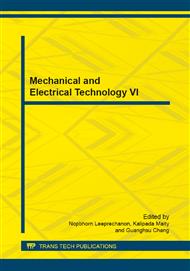[1]
K. Mitra, and S. Kumar, Development and Comparison of Models for Light-Pulse Transport through Scattering-Absorbing Media,J. Appl. Opt., Vol. 38 (1) (1999), p.188–196.
DOI: 10.1364/ao.38.000188
Google Scholar
[2]
A.L. Crosbie, and R.L. Dougherty, Two-Dimensional Linearly Anisotropic Scattering in a Semi-Infinite Cylindrical Medium Exposed to a Laser Beam, J. Quant. Spectrosc. Radiat. Transf., Vol. 28 ( 3) (1982) , p.233–263.
DOI: 10.1016/0022-4073(82)90026-7
Google Scholar
[3]
M.P. Menguc, and R. Viskanta, Radiation Heat Transfer in Combustion Systems, Prog. Energy Combust. Sci., Vol. 13, (1987), p.97–160.
Google Scholar
[4]
J.A. Weinman, and S.T. Shipley, Effects of Multiple Scattering on Laser Pulses Transmitted Through Clouds, J. Geophys. Res., Vol. 77 (1972), p.7123–7128.
DOI: 10.1029/jc077i036p07123
Google Scholar
[5]
Y. Yamada, Light-Tissue Interaction and Optical Imaging in Biomedicine-Annual Review of Fluid Mechanics and Heat Transfer C.L. Tien, ed., 6, Begell House, New York, (1995), pp.1-59.
DOI: 10.1615/annualrevheattransfer.v6.30
Google Scholar
[6]
A. Majumdar, Microscale Energy Transport in Solids, Begell House, New York, (1998) p.1–93.
Google Scholar
[7]
J.P. Longtin, and C.L. Tien, Saturable Absorption during High Intensity Laser Heating of Liquids, ASME J. Heat Transfer., Vol. 118 (1996) , p.924–930.
DOI: 10.1115/1.2822590
Google Scholar
[8]
T.Q. Qiu, and C.L. Tien, Short Pulse Laser Heating in Metals, Int. J. Heat Mass Transf., Vol. 35 (1992) , p.719–726.
DOI: 10.1016/0017-9310(92)90131-b
Google Scholar
[9]
F. Liu, K.M. Yoo, and R.R. Alfano, 1993, Ultrafast Laser-Pulse Transmission and Imaging through Biological Tissues, Appl. Opt., Vol. 32, No. 4 (1993) , p.554–558.
DOI: 10.1364/ao.32.000554
Google Scholar
[10]
M.J.C. Gemert, and A.J. Welch, Clinical Use of Laser-Tissue Interaction, IEEE Eng. Med. Biol. Mag., (1989), p.10–13.
DOI: 10.1109/51.45950
Google Scholar
[11]
K.J. Grant, J.A. Piper, D.J. Ramsay, and K.L. Williams, Pulse Lasers in Particle Detection and Sizing, Appl. Opt., Vol. 32, No. 4 (1993), p.416–417.
DOI: 10.1364/ao.32.000416
Google Scholar
[12]
K. Mitra, and S. Kumar, Application of Transient Radiative Transfer Equation to Oceanographic Lidar, ASME HTD-Vol. 353 (1997), p.359–365.
DOI: 10.1115/imece1997-0928
Google Scholar
[13]
D.W. Balsara, An Analysis of the Hyperbolic Nature of the Equations of Radiation Hydrodynamics, J. Quant. Spectrosc. Radiat. Transf., Vol. 61, No. 5 (1999), p.617–627.
Google Scholar
[14]
J. C. Chai , One-dimensional transient radiation heat transfer modeling using a finite-volume method, Numer. Heat Transf., 44(2003), pp.187-208.
DOI: 10.1080/713836346
Google Scholar


